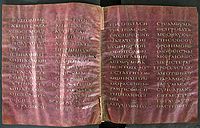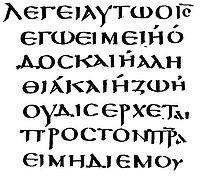- Codex Petropolitanus Purpureus
-
For the similarly named manuscript, see Codex Petropolitanus (New Testament).
New Testament manuscripts
papyri • uncials • minuscules • lectionariesUncial 022
Matthew 10:10-17Name Petropolitanus Purpureus Sign N Text Gospels Date 6th century Script Greek Found Sarmisahly (or Sarumsahly) Now at National Library of Russia Size 32 cm x 27 cm Type Byzantine Category V Note purple codex Codex Petropolitanus Purpureus, designated by N or 022 (in the Gregory-Aland numbering), ε 19 (Soden), is a 6th century Greek New Testament codex gospel book. Written in majuscules (capital letters), on 231 parchment leaves, measuring 32 x 27 cm. Paleographically it has been assigned to the 6th century.[1]
Codex Petropolitanus Purpureus, along with the manuscripts Φ, O, and Σ, belongs to the group of the Purple Uncials. The manuscript is very lacunose.[1]
Contents
Description
It contains text of the four Gospels with a large number of lacunae.[1] The manuscript text is in two columns, 16 lines, 12 letters in line, in large uncial letters. The lettering is in silver ink on vellum dyed purple, with gold ink for nomina sacra (ΙΣ, ΘΣ, ΚΣ, ΥΣ, and ΣΩΤΗΡ). It has errors of iotacisms, as the change of ι and ει, αι and ε.[2]
It can be calculated that the original codex contained 462 leaves.[3]
Before each Gospels, the tables of κεφαλαια (tables of contents) were placed. The text is divided according to the κεφαλαια (chapters), whose numbers are given at the margin. At the top of the pages τίτλοι (titles of chapters) are preserved. The Ammonian sections and the Eusebian Canons are presented in the margin.[2]
Lacunae
Gospel of Matthew 1:1-24, 2:7-20, 3:4-6:24, 7:15-8:1, 8:24-31, 10:28-11:3, 12:40-13:4, 13:33-41, 14:6-22, 15:14-31, 16:7-18:5, 18:26-19:6, 19:13-20:6, 21:19-26:57, 26:65-27:26, 26:34-end;
Gospel of Mark 1:1-5:20. 7:4-20, 8:32-9:1, 10:43-11:7, 12:19-24:25, 15:23-33, 15:42-16:20;
Gospel of Luke 1:1-2:23, 4:3-19, 4:26-35, 4:42-5:12, 5:33-9:7, 9:21-28, 9:36-58, 10:4-12, 10:35-11:14, 11:23-12:12, 12:21-29, 18:32-19:17, 20:30-21:22, 22:49-57, 23:41-24:13, 24:21-39, 24:49-end;
Gospel of John 1:1-21, 1:39-2:6, 3:30-4:5, 5:3-10, 5:19-26, 6:49-57, 9:33-14:2, 14:11-15:14, 15:22-16:15, 20:23-25, 20:28-30, 21:20-end.[4]
Text
The text of the codex is a representative of the Byzantine text-type, with numerous pre-Byzantine readings.[5] According to Scrivener "it exhibits strong Alexandrian forms."[6] According to Streeter in some parts it has the Caesarean redings. Aland placed it in Category V,[1] and it is certain that it is more Byzantine than anything else.
The texts of Luke 22:43-44, and John 7:53–8:11 are omitted.
In John 1:27 it has additional reading εκεινος υμας Βαπτιζει εν πνευματι αγιω και πυρι.[7]
History
It is understood that the manuscript originated in the imperial scriptorium of Constantinople and was dismembered by crusaders in the 12th century. In 1896 Nicholas II of Russia commissioned Fyodor Uspensky's Russian Archaeological Institute of Constantinople to buy the greater part of it for the Imperial Public Library in St. Petersburg.[2]
The codex was examined by Lambeck, Montfaucon, Hermann Treschow, Alter, Hartel, Wickholf, Bianchini, and Duchesne.
Wettstein in 1715 examined 4 leaves housed at London (Cotton Titus C. XV) and marked them by I.[8] Wettstein cited only 5 of its readings. According to Scrivener it has 57 various readings.[9][10] Bianchini described portions housed at the Vatican Library. The same portions examined and collated for Scholz Gaetano Luigi Marini.
Vienna fragments, Codex Vindobonensis, were examined by Wettstein, who marked them by siglum N.[11] Treschow in 1773 and Alter in 1787 had given imperfect collations of Vienna fragments.[12] Peter Lambeck gave the wrong suggestion that Vienna fragments and Vienna Genesis originally belonged to the same codex.[2][13]
Tischendorf published fragments of this manuscript in 1846 in his Monumenta sacra et profana. Tischendorf considered it as a fragment of the same codex as 6 leaves from Vatican, and 2 leaves from Vienna.[14]
Louis Duchesne described the Patmos portions (1876).[15] Athens and New York portions were edited by Stanley Rypins in 1956.
A facsimile of all fragments was published 2002 in Athens.[16]
Present location
The 231 extant folios of the manuscript are kept in different libraries:
- 182 leaves in the National Library of Russia in Saint Petersburg,
- 33 leaves in the Library of the Monastery of Saint John the Theologian on the Island of Patmos, Greece, Mark 6:53-7:4; 7:20-8:32; 9:1-10:43; 11:7-12:19; 14:25-15:23;
- 6 leaves in the Vatican Library in Rome, Matthew 19:6-13; 20:6-22; 20:29-21:19
- 4 leaves in London, British Library, Cotton Titus C. XV; Matthew 26:57-65; 27:26-34; John 14:2-10; 15:15-22; they were named the Codex Cottonianus;
- 2 leaves in the National Library of Austria in Vienna,
- 1 leaf in the Morgan Library in New York,
- 1 leaf in the Byzantine Museum in Athens,
- 1 leaf in the Museum of Byzantine Culture in Thessaloniki
- 1 leaf in the private collection of Marquis А. Spinola in Lerma (1), Italy.
See also
References
- ^ a b c d Aland, Kurt; Barbara Aland; Erroll F. Rhodes (trans.) (1995). The Text of the New Testament: An Introduction to the Critical Editions and to the Theory and Practice of Modern Textual Criticism. Grand Rapids: William B. Eerdmans Publishing Company. p. 113. ISBN 978-0-8028-4098-1.
- ^ a b c d Gregory, Caspar René (1900). Textkritik des Neuen Testaments. 1. Leipzig: J.C. Hinrichs’sche Buchhandlung. pp. 56–58. http://www.archive.org/stream/textkritikdesne00greggoog#page/n69/mode/2up.
- ^ Frederic G. Kenyon, "Handbook to the Textual Criticism of the New Testament", London2, 1912, pp. 110.
- ^ NA26, p. 691.
- ^ Metzger, Bruce M.; Ehrman, Bart D. (2005). The Text of the New Testament: Its Transmission, Corruption and Restoration (4 ed.). New York – Oxford: Oxford University Press. p. 79. ISBN 978-0-19-516122-9.
- ^ Scrivener, Frederick Henry Ambrose; Edward Miller (1894). A Plain Introduction to the Criticism of the New Testament. 1 (4th ed.). London: George Bell & Sons. p. 141.
- ^ NA26, p. 249
- ^ Wettstein, Johann Jakob (1751) (in Latin). Novum Testamentum Graecum editionis receptae cum lectionibus variantibus codicum manuscripts. 1. Amsterdam: Ex Officina Dommeriana. p. 40. http://www.archive.org/stream/hekainediatheken00clem#page/40/mode/2up. Retrieved November 14 2010.
- ^ Scrivener, F. H. A., A Full and Exact Collation of About 20 Greek Manuscripts of the Holy Gospels (Cambridge and London, 1852), p. XL.
- ^ Scrivener, Frederick Henry Ambrose; Edward Miller (1894). A Plain Introduction to the Criticism of the New Testament. 1 (4 ed.). London: George Bell & Sons. pp. 139–140.
- ^ Wettstein, Johann Jakob (1751) (in Latin). Novum Testamentum Graecum editionis receptae cum lectionibus variantibus codicum manuscripts. 1. Amsterdam: Ex Officina Dommeriana. p. 41. http://www.archive.org/stream/hekainediatheken00clem#page/40/mode/2up. Retrieved November 14 2010.
- ^ F. K. Alter, Novum Testamentum Graecum, ad Codicem Vindobonensem Graece expressum: Varietam Lectionis addidit Franciscus Carolus Alter, 1 vol., Vienna, 999-1001.
- ^ P. Lambeck, Commentarii De Augustissima Bibliotheca Caesarea Vindobonensi ed. alt. opera et studio Adami Franc. Kollarii, Wien, Bd. (Buch) 3 (l776), col. 30-32.
- ^ F. H. A. Scrivener, A Full and Exact Collation of About 20 Greek Manuscripts of the Holy Gospels (Cambridge and London, 1852), p. XL.
- ^ L. Duchesne, Archives des missions scientifiques et littéraires (Paris, 1876), vol. 3, pp. 386-419.
- ^ The purple codex of the Gospels of Patmos and Petroupolis, Athens 2002.
Further reading
- Constantin von Tischendorf, „Monumenta sacra inedita“ (Leipzig, 1846), pp. 15–24.
- S. P. Tregelles, "An Introduction to the Critical study and Knowledge of the Holy Scriptures", London 1856, pp. 177–178.
- F. H. A. Scrivener, A Full and Exact Collation of About 20 Greek Manuscripts of the Holy Gospels (Cambridge and London, 1852), p. XL. (as j)
- Louis Duchesne, Archives des missions scientifiques et littéraires (Parigi, 1876), vol. 3, pp. 386–419.
- H. S. Cronin, "Codex Purpureus Petropolitanus. The text of Codex N of the gospels edited with an introduction and an appendix", T & S, vol. 5, no. 4 (Cambridge, 1899).
- C. R. Gregory, "Textkritik des Neuen Testaments", Leipzig 1900, vol. 1, pp. 56–59.
- S. Rypins, Two Inedited Leaves of Codex N, JBL Vol. 75, No. 1 (Mar. 1956), pp. 27–39.
External links
- Codex Petropolitanus Purpureus N (022) at the Encyclopedia of Textual Criticism
- Codex Petropolitanus Purpureus at the National Library of Russia, 2007
Categories:- Greek New Testament uncials
- Purple parchment
- 6th-century biblical manuscripts
Wikimedia Foundation. 2010.


